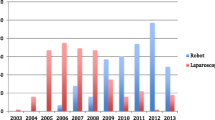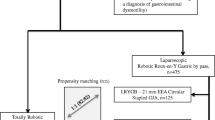Abstract
Background Roux-en-Y gastric bypass is considered to be the gold standard of bariatric procedures. Minimally invasive surgical techniques have been demonstrated to decrease recovery time and provide for favorable cosmetic outcomes. The drawback of traditional laparoscopic techniques for the surgeon comes in the form of 2D monitoring of not always intuitive instrument manipulation. The da Vinci Surgical System provides surgeons with a 3D view and more intuitive instrument manipulation. This study was conducted in order to compare the surgical outcomes and assess the learning curve of traditional laparoscopic Roux-en-Y gastric bypasses (LRYGB) to totally robotic Roux-en-Y gastric bypasses (TRRYGB). A single surgeon’s 100 most recent patients who underwent traditional LRYGB and the first 100 patients who underwent TRRYGB were included in this study. Data was collected on patient age, gender, body mass index (BMI), co-morbidities, surgical time, length of admission, and complication rates. No significant differences were found between study groups with respect to age, gender, BMI or any recorded co-morbidities. The mean operative times for patients 1–50 in the TRRYGB and LRYGB groups were 204.34 ± 90.19 min and 151.16 ± 47.16 min, respectively (P = 0.0004). Mean operative times were 159.60 ± 48.26 min and 166.66 ± 44.95 min for patients 51–100 in the TRRYGB and LRYGB groups, respectively (P = 0.45). No significant differences were found between study groups with respect to post-surgical complications or 30-day outcomes. Our data shows that TRRYGB compares favorably to the traditional laparoscopic approach, while maintaining patient safety.
Similar content being viewed by others
References
Ogden CL, Carroll MD, Kit BK, Flegal KM (2012) Prevalence of obesity in the United States, 2009–2010. NCHS Data Brief No. 82
Centers for Disease Control and Prevention (2010) Prevalence of overweight, obesity, and extreme obesity among adults: United States, Trends 1976–1980 through 2007–2008
Consensus Development Conference Panel (1991) Gastrointestinal surgery for severe obesity: consensus development conference statement. Ann Intern Med 115:956–961
Finkelstein EA (2009) Annual medical spending attributable to obesity: Payer-and service-specific estimates. Health Aff 29(5):822–831
Christou NV, Sampalis JS, Liberman M, Look D, Auger S, McLean AP, MacLean LD (2004) Surgery decreases long-term mortality, morbidity and health care use in the morbidly obese patients. Ann Surg 240:416–423
Strauss B, Marks S, Schachter L, Chapman L, Anderson M (2006) Treatment of mild to moderate obesity with laparoscopic adjustable gastric banding or an intensive medical program: a randomized trial. Ann Intern Med 144:625–633
Schauer PR, Ikramuddin S, Gourash W, Ramanathan R, Luketich J (2000) Outcomes after laparoscopic Roux-en-Y gastric bypass for morbid obesity. Ann Surg 232:515–529
Steinbrook R (2004) Surgery for severe obesity. N Engl J Med 350:1075–1079
Robinson MK (2009) Surgical treatment of obesity—weighing the facts. N Engl J Med 361(5):520–521
Mason EE, Ito C (1967) Gastric bypass in obesity. Surg Clin North Am 47:1345–1352
Markar SR, Karthikesalingam AP, Venkat-Ramen V, Kinross J, Ziprin P (2011) Robotic vs. laparoscopic Roux-en-Y gastric bypass in morbidly obese patients: systematic review and pooled analysis. Int J Med Robot 7:393–400
Bult MJ, van Dalen T, Muller AF (2008) Surgical treatment of obesity. Eur J Endocrinol 158(2):135–145
Wittgrove AC, Clark GW, Tremblay LJ (1994) Laparoscopic gastric bypass, Roux-en-Y: preliminary report of five cases. Obes Surg 4:353–357
Kim KC, Buffington C (2011) Totally robotic gastric bypass: approach and technique. J Robotic Surg 5:47–50
Ayloo SM, Addeo P, Buchs NC, Shah G, Giulianotti PC (2011) Robot-assisted versus laparoscopic Roux-en-Y gastric bypass:is there a difference in outcomes? World J Surg 35:637–642
Madan AK, Speck KE, Hiler ML (2004) Routine preoperative upper endoscopy for laparoscopic gastric bypass: is it necessary? Ann Surg 70:684–686
Talamini MA, Chapman S, Horgan S, Melvin WS (2003) A prospective analysis of 211 robotic-assisted surgical procedures. Surg Endosc 17:1521–1524
Oliak D, Ballantyne GH, Weber P, Wasielewski A, Davies RJ, Schmidt HJ (2003) Laparoscopic Roux-en-Y gastric bypass—defining the learning curve. Surg Endosc 17:406–408
Schauer P, Ikramuddin S, Hamad G, Gourash W (2003) The learning curve for laparoscopic Roux-en-Y gastric bypass is 100 cases. Surg Endosc 17:212–215
Conflict of interest
None.
Author information
Authors and Affiliations
Corresponding author
Rights and permissions
About this article
Cite this article
Wood, M.H., Kroll, J.J. & Garretson, B. A comparison of outcomes between the traditional laparoscopic and totally robotic Roux-en-Y gastric bypass procedures. J Robotic Surg 8, 29–34 (2014). https://doi.org/10.1007/s11701-013-0416-1
Received:
Accepted:
Published:
Issue Date:
DOI: https://doi.org/10.1007/s11701-013-0416-1




